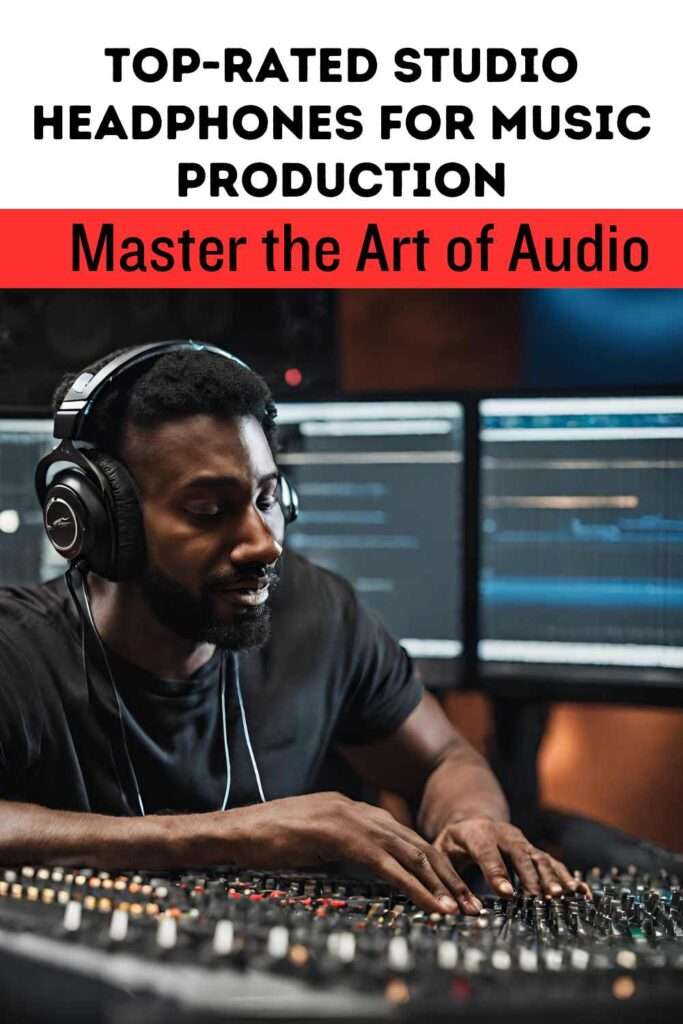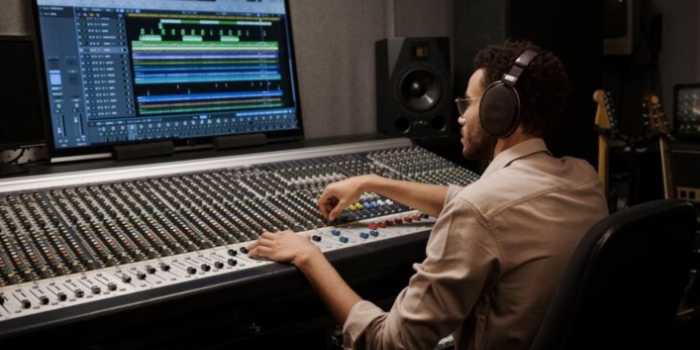Every beat, every melody, and every note calls for pinpoint accuracy and crystal-clear articulation when it comes to the production of music.
In your role as a creative virtuoso, the most important tool at your disposal is a dependable set of studio headphones.
These can turn your workspace into a portal to audio perfection. Join us as we embark on an exhilarating adventure as we delve into the world of top-rated studio headphones, where unrivaled audio fidelity meets supreme comfort, elevating your sonic craftsmanship to new heights.
Step into a world where music defies categorization and where the avant-garde and the fantastical coexist in perfect harmony. Find out how to reach your full potential as a music producer by consulting this comprehensive guide to the best studio headphones the market has to offer.
The Ultimate Guide to Studio Headphones for Music Production
In this topic we will cover:-
- Understanding Studio Headphones
- Types of Studio Headphones
- Key Features to Look for in Studio Headphones
- Criteria for Selection
- 5 Studio Headphones for Music Production
- Taking Care of Your Studio Headphones
1. Understanding Studio Headphones

Studio headphones are an essential piece of equipment for the process of making music because they allow producers and audio engineers to monitor and evaluate their work in a way that is both direct and accurate.
Studio headphones, in contrast to consumer headphones designed for casual listening, are purposely engineered to deliver a frequency response that is neutral and uncolored.
This indicates that they reproduce sound as accurately as they possibly can, without boosting or enhancing particular frequencies in an effort to make the music sound more appealing.
2. Types of Studio Headphones:

Open-Back Headphones: These headphones have ear cups that are perforated to allow air and sound to pass through.
This creates a soundstage that is more open and spacious. Because of their reputation for producing sound that is both natural and transparent, they are frequently used for critical listening and other mixing-related tasks.
Closed-Back Headphones Closed-back headphones have ear cups that are hermetically sealed to prevent sound from leaking out and to isolate the listener from any outside noise that may interfere with their enjoyment of the music.
They have a sound that is more concentrated and personal, which makes them suitable for tracking and recording in loud environments.
Semi-Open Headphones: As the name suggests, semi-open headphones combine aspects of both open-back and closed-back designs.
These headphones are typically more expensive than their open-back and closed-back counterparts. In comparison to closed-back models, they offer some degree of isolation while simultaneously providing a more expansive soundstage.
3. Key Features to Look for in Studio Headphones

Frequency response range The ability of headphones to faithfully reproduce both low and high frequencies is dependent on the frequency response range of the headphones. A wide frequency response range is essential for accurate monitoring.
Sensitivity: Headphones with a higher sensitivity require less power to achieve a specific volume level, which makes them compatible with a wider range of audio devices.
Impedance is a factor that influences how headphones interact with different types of audio sources. Headphones with a lower impedance are better suited for portable electronic devices, whereas headphones with a higher impedance may require dedicated headphone amplifiers.
Noise Isolation: Closed-back headphones are superior to open-back headphones when it comes to noise isolation because they block out ambient sounds. This feature is essential for recording and critical listening sessions.
Comfort and the Quality of the Build: Given that music production sessions can last for a significant amount of time, it is essential to prioritize comfort and durability in order to avoid experiencing any discomfort during extended use.
Cable Options and Connectors Detachable cables that come with a variety of connector types offer both convenience and flexibility, making it possible for you to switch between different devices in a straightforward manner.
4. Criteria for Selection
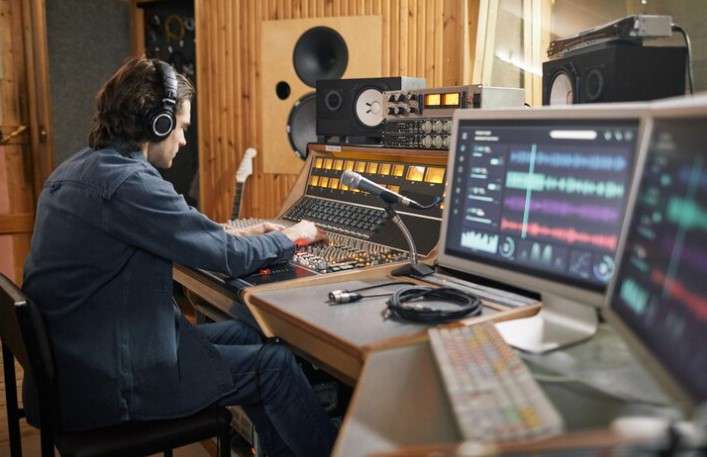
It is important to give careful consideration to a wide range of factors when searching for the ideal pair of studio headphones for use in the production of music.
This will ensure that the headphones meet your individual requirements and preferences. When considering the various choices available to you, the following is a list of the most important criteria to keep in mind
Look for headphones that have a wide and flat frequency response, ideally covering the entire audible spectrum from 20 Hz all the way up to 20 kHz.
A flat response guarantees the accurate reproduction of all frequencies, which is absolutely necessary for accurate mixing and mastering.
Sensitivity: Headphones with a higher sensitivity will produce louder sound levels with less power than lower-sensitivity models, making them compatible with a wider variety of audio sources.
However, headphones with an exceptionally high sensitivity level may be more prone to distortion at higher volumes.
Impedance: It is important to take into consideration the impedance of the headphones in relation to your audio interface or any other devices that you intend to use them with.
While headphones with a lower impedance (around 16-32 ohms) are better suited for portable devices, headphones with a higher impedance (over 100 ohms) may require dedicated headphone amplifiers for optimal performance.
Noise Isolation and Sound Leakage: Closed-back headphones provide better noise isolation than open-back headphones, preventing your monitoring from being disrupted by sounds from the outside world.
In a similar vein, having a low amount of sound leakage ensures that the audio you are listening to will not escape the headphones and distract those around you.
Comfort and Build Quality: Because recording and producing music can take a long time, it is essential to have comfortable equipment.
Look for headphones that have headbands that can be adjusted, ear cups that are adequately padded, and a design that is not too heavy. Choose models that are constructed with long-lasting materials so that they can withstand frequent use.
Sound Signature: When selecting headphones, it is important to take into consideration their sound signature. Some models may have a sound that is neutral and balanced, while others may have a presentation that leans more toward being bright or having a heavy emphasis on bass.
Choose a sound signature that fits in well with the kind of music you like to listen to and the way you produce it.
Options for Cables and Connectors Having cables that are detachable offers a number of benefits, including the ability to easily replace them and the flexibility to select from a variety of cable types, lengths, and connectors.
Always look for cables that are long-lasting, knot-free, and have reliable connectors.
User Reviews and Testimonials: Do some research on user reviews and testimonials in order to collect real-world feedback on the headphones’ performance as well as their durability and overall user experience.
Considerations Regarding the Budget You should establish a budget according to your requirements and top priorities. Although there are some excellent options available at more reasonable price points, top-of-the-line studio headphones can be quite pricey.
Reputation of the Brand Well-known brands that have a track record of manufacturing high-quality audio equipment are more likely to instill confidence in their wares.
However, you should not disregard less well-known brands because they might offer features and performance that are comparable.
5. 5 Studio Headphones for Music Production
1. Sony MDR-7506:
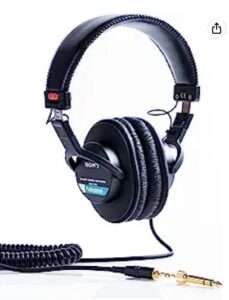
The Sony MDR-7506 is a time-tested and dependable option for those working in the music production industry. It is renowned for having an accurate and flat frequency response, which enables it to produce audio that is true to the source.
Because of its closed-back design, it offers superior noise isolation, making it an excellent choice for recording and critical listening.
Because of their low weight and high level of comfort, these headphones are ideal for long sessions in the recording studio. The MDR-7506, which has a stellar reputation in the business and has been around for a very long time, is still an excellent choice for both established and aspiring producers.
Key Features
- Closed-back, circumaural (over-ear) design for good noise isolation and immersive listening experience.
- 40mm drivers with neodymium magnets for clear and accurate sound reproduction.
- Wide frequency response range of 10Hz to 20kHz, allowing for detailed audio monitoring.
- Impedance of 63 ohms, making them compatible with a variety of audio devices without the need for a headphone amplifier.
- Sensitivity of 106 dB, providing sufficient volume levels even with low-powered devices.
- Coiled and detachable 9.8-foot cable, offering flexibility and convenience during use.
- Comfortable ear pads and adjustable headband for extended studio sessions.
- Frequency response tailored for professional monitoring, mixing, and sound engineering tasks.
Pros:
- Accurate and Flat Frequency Response: Delivers precise and uncolored sound reproduction, ideal for critical listening and mixing tasks.
- Closed-Back Design: Offers excellent noise isolation, making it suitable for use in noisy environments and during recording sessions.
- Durable Build: Sturdy construction ensures longevity, even with frequent use in professional settings.
- Comfortable Fit: Padded ear cups and adjustable headband provide comfort during extended studio sessions.
- Portable: Foldable design and included carry pouch make it easy to transport and store.
- Industry Standard: Widely used in studios and respected by professionals for decades.
Cons:
- Slightly Heavy: Some users may find them a bit weighty during extended use.
- Limited Soundstage: Compared to open-back headphones, the soundstage may feel narrower, affecting the perceived spatiality of the audio.
- Non-Detachable Cable: The cable is fixed to the headphones, which means it cannot be easily replaced if damaged.
2. Audio-Technica ATH-M50x
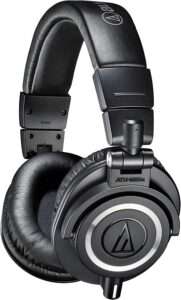
Because of its remarkable sound quality and robust construction, the Audio-Technica ATH-M50x is a popular choice among producers of musical works.
The sound signature of these closed-back headphones is well balanced, with a slight emphasis on the low end. As a result, they are suitable for listening to a wide variety of musical styles.
Because of their collapsible design and swiveling ear cups, these headphones are portable and convenient for use while on the go.
The ATH-M50x has garnered praise for its durable construction, comfortable design, and detachable cables, which allow for greater versatility in cable choice.
Key Features
- Professional-grade closed-back studio headphones.
- 45mm large-aperture drivers for exceptional audio clarity and accuracy.
- Comes with three interchangeable cables: 1.2m-3m coiled cable, 3m straight cable, and 1.2m straight cable.
- Ear cups with thick cushioning for comfort during extended sessions.
- Sound signature with accurate bass response and well-balanced midrange and treble.
- Excellent noise isolation for focused monitoring in loud environments.
- Frequency response range of 15Hz to 28kHz, providing an extended range for accurate audio reproduction.
- Impedance of 38 ohms, making them compatible with various audio devices.
- Sensitivity of 99 dB, ensuring sufficient volume levels without the need for high power sources.
- Widely regarded as a go-to choice for music producers, audio engineers, and DJs due to their reliable performance and sound quality.
Pros:
- Excellent Sound Quality: The ATH-M50x offers clear, detailed, and balanced sound reproduction, making it suitable for mixing, tracking, and casual listening.
- Detachable Cables: The headphones come with detachable cables, providing versatility and easy replacement if cables get damaged.
- Comfortable Fit: The plush ear pads and adjustable headband ensure a comfortable fit, even during extended studio sessions.
- Collapsible Design: The headphones fold up for easy portability and storage, making them convenient for on-the-go use.
- Excellent Noise Isolation: The closed-back design provides effective noise isolation, allowing for focused monitoring in noisy environments.
- Durable Build: The ATH-M50x is constructed with high-quality materials, ensuring sturdiness and longevity.
- Versatile Usage: Suitable for various music genres and multimedia applications, including studio work, casual listening, and gaming.
Cons:
- Slightly Heavy: Some users may find the headphones a bit heavy during extended use, potentially causing discomfort.
- Sound Leakage: Although the closed-back design provides good noise isolation, sound leakage can still be noticeable at higher volume levels.
- Limited Soundstage: The closed-back nature of the headphones may result in a slightly limited soundstage compared to open-back models.
3. Beyerdynamic DT 770 Pro
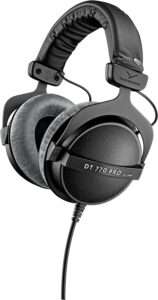
The Beyerdynamic DT 770 Pro is a closed-back studio headphone that is highly regarded for its excellent comfort as well as its superior sound isolation.
Because of its precise and detailed sound reproduction, it is an excellent choice for critical listening, mixing, and mastering duties.
The ear pads are made of velour, and the headband can be adjusted to ensure a comfortable fit even for longer listening sessions.
Users are able to select the model that most closely resembles their ideal listening environment thanks to the availability of a wide range of impedance options.
Key Features
- Closed-back design for excellent noise isolation and minimal sound leakage.
- Available in different impedance options: 32 ohms, 80 ohms, and 250 ohms, catering to various setups and preferences.
- Wide frequency response range of 5Hz to 35kHz, ensuring accurate sound reproduction across the entire audible spectrum.
- High sensitivity of 96 dB/mW (for 80 ohms version), providing ample volume levels even with low-powered devices.
- Comfortable over-ear design with soft, replaceable ear pads and an adjustable headband for extended studio sessions.
- Single-sided, coiled cable (1.6m – 3m) with a 3.5mm jack and 6.35mm adapter, offering flexibility and compatibility with different audio sources.
- Professional-grade drivers with excellent transient response and dynamic range for precise audio monitoring and critical listening.
- Trusted by audio professionals and music producers worldwide for its high performance and reliability.
Pros:
- Excellent Sound Isolation: The closed-back design provides outstanding noise isolation, making them suitable for recording and critical listening in noisy environments.
- Accurate Sound Reproduction: These headphones have a balanced and accurate sound signature, making them ideal for mixing and mastering tasks.
- Comfortable for Extended Use: The DT 770 Pro features a well-padded headband and soft ear cushions, ensuring comfort during prolonged studio sessions.
- Durable Build: The headphones are constructed with high-quality materials, making them sturdy and durable for regular studio use.
- Replaceable Parts: Key components like ear pads, headband, and cable are replaceable, increasing the longevity of the headphones.
- Various Impedance Options: Available in different impedance versions (32, 80, and 250 ohms), allowing users to choose based on their equipment and listening preferences.
- Detachable Cable: The detachable coiled cable provides flexibility and convenience, and it can be easily replaced if damaged.
Cons:
- Bulky Design: Some users may find the headphones bulky and less portable for on-the-go use.
- Non-Foldable: Unlike some other headphones, the DT 770 Pro does not fold or collapse, which may impact portability.
- Limited Soundstage: As closed-back headphones, the soundstage may not be as wide and spacious as open-back alternatives.
- Cable Not Replaceable with Standard 3.5mm: The DT 770 Pro’s cable terminates in a proprietary connector, so users need to purchase a compatible replacement cable if needed.
Sennheiser HD 650
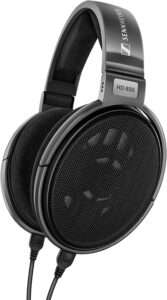
The sound signature of the high-end open-back headphones made by Sennheiser called the HD 650 is renowned for being both natural and transparent.
Because of its attention to detail and expansive soundstage, it offers an immersive listening experience and is therefore a popular option among engineers who specialize in mixing and mastering.
Velour ear pads and other high-quality components contribute to the headphones’ exceptional level of wearability and comfort.
Their high audio fidelity and pinpoint accuracy have made them a favorite among audiophiles and professional producers, despite the fact that they require a dedicated headphone amplifier for optimal performance.
Key Features
- Open-back design for a natural and spacious soundstage.
- High-quality, hand-picked neodymium magnets for exceptional audio accuracy.
- Lightweight aluminum voice coils for fast transient response.
- Neutral and balanced sound signature, making it ideal for critical listening and mixing tasks.
- Frequency response: 10 Hz – 41 kHz, ensuring detailed reproduction across the entire audio spectrum.
- Impedance: 300 ohms, requiring a dedicated headphone amplifier for optimal performance.
- Detachable cable with a 1/4-inch (6.3mm) stereo plug for versatility and easy replacement.
- Suitable for audiophiles, music producers, and professional engineers seeking precision and transparency in sound.
- Legendary build quality and durability, contributing to its long-standing reputation as a high-end studio headphone.
Cons
- Exceptional Sound Quality: Offers a natural, transparent, and well-balanced sound signature, making it ideal for critical listening, mixing, and mastering tasks.
- Wide Soundstage: Provides an immersive and spacious soundstage, allowing for better spatial awareness and separation of instruments.
- Comfortable Design: Features plush velour ear pads and an adjustable headband, ensuring extended listening sessions without discomfort.
- Premium Build Quality: Constructed with high-quality materials, ensuring durability and longevity.
- Detachable Cable: Comes with a detachable cable, offering flexibility for cable replacement or customization.
- Ideal for Audiophiles: Highly praised by audiophiles for its accurate audio reproduction and high-fidelity performance.
Cons:
- High Impedance: With an impedance of 300 ohms, it may require a dedicated headphone amplifier for optimal performance.
- Not Ideal for Portable Use: Due to its open-back design and higher impedance, it is less suitable for on-the-go or portable use with mobile devices.
- Bulky Design: The large size and open-back design may not provide as much noise isolation, making it less suitable for use in noisy environments.
- Price: The HD 650 is relatively expensive compared to some other studio headphone options, which may be a deterrent for budget-conscious buyers.
AKG K240 Studio:
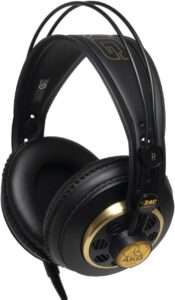
The AKG K240 Studio is a low-cost semi-open headphone that is ideal for home studios and aspiring producers. It produces a balanced and accurate sound with a slightly accentuated midrange, making it ideal for tracking and critical listening.
Comfort and durability are ensured by the self-adjusting headband and replaceable ear pads. The K240 Studio has been a studio staple for decades, providing a dependable and cost-effective option for those just starting out in music production.
It’s important to remember that each producer’s preferences and needs will vary, so it’s best to try out headphones before making a final decision.
Sound signature, comfort, durability, and price are all important factors in determining the best fit for your music production endeavors.
The headphones listed above represent a wide range of options, catering to a variety of budgets and needs while maintaining the quality and accuracy required for professional music production.
Key Features
- Semi-open design with solid bass response and natural soundstage.
- Over-ear design with circumaural ear cups for comfort during extended use.
- Self-adjusting headband for a secure and personalized fit.
- Replaceable ear pads for easy maintenance and longevity.
- 55-ohm impedance, suitable for use with a variety of audio devices.
- Gold-plated 3.5mm plug with included 1/4″ adapter for versatile connectivity options.
- Highly regarded for their accuracy and transparent sound signature, making them ideal for critical listening, mixing, and tracking tasks.
- Made by AKG, a reputable brand known for producing professional-grade audio equipment.
Pros:
- Accurate and neutral sound signature, making it suitable for critical listening and mixing tasks.
- Semi-open design provides a natural and spacious soundstage, contributing to an immersive listening experience.
- Comfortable fit with self-adjusting headband and replaceable velour ear pads, allowing for extended studio sessions.
- Detachable cable design for easy replacement and flexibility in cable options.
- Durable construction and well-regarded build quality, ensuring longevity.
- Affordable price point, making it an excellent option for budget-conscious producers and home studios.
- Suitable for various music genres, thanks to its balanced sound presentation.
- Relatively lightweight and portable design, suitable for on-the-go use.
Cons:
- Semi-open design may not provide the same level of noise isolation as closed-back headphones, potentially leading to sound leakage and distractions during recording sessions.
- The sound signature may not suit those seeking heavily emphasized bass or treble.
- The headphone’s impedance may not be ideal for use with low-powered devices like smartphones or portable music players, potentially requiring a headphone amplifier for optimal performance.
6. Tips for Choosing the Perfect Studio Headphones
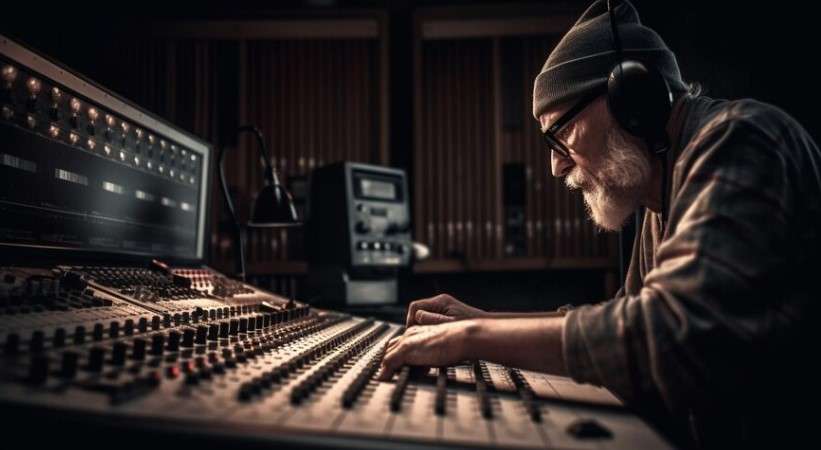
Choosing the ideal headphones for your studio is an important decision that can have a significant bearing on the efficiency of your music production workflow as well as the quality of the audio you produce.
The following is a list of important guidelines that will assist you in selecting the ideal pair of studio headphones:
Define Your Purpose and Budget:
Decide what your primary use for the headphones will be. Are they intended for mixing, tracking, mastering, or general use? Specific features or sound signatures may be required for different tasks.
Create a budget that reflects your needs and quality expectations. Although high-end studio headphones provide superior performance, there are also excellent options available at lower price points.
Research and Read Reviews:
Do extensive research on various models and brands. Read professional and user reviews to learn about actual user experiences with the headphones.
Look for reviews from other music producers or engineers to get a sense of how the headphones perform in the studio.
Think about the type and design:
Choose open-back, closed-back, or semi-open headphones based on your preferences for soundstage, isolation, and leakage.
Consider the design’s comfort and ergonomics, especially if you intend to use the headphones for extended periods of time.
Assess Sound Quality and Frequency Response: For accurate audio monitoring, look for headphones with a flat, neutral frequency response. This prevents the headphones from artificially emphasizing specific frequencies.
To evaluate the sound signature and performance of the headphones, listen to familiar tracks from various genres.
Check Impedance and Sensitivity: To avoid problems with volume levels and sound quality, make sure the impedance of the headphones matches that of your audio interface or equipment.
Higher sensitivity headphones are more versatile in general, as they can be used with a wider range of devices.
Closed-back headphones provide better noise isolation, making them suitable for recording and critical listening in noisy environments.
Although open-back headphones produce a more natural and spacious sound, they may not be ideal if external noise is a factor.
Test for Comfort and Fit: If possible, try on the headphones before purchasing, or read about the fit and comfort in user reviews. Long studio sessions require a high level of comfort.
To improve comfort, look for models with adjustable headbands and cushioned ear pads.
Check the Cable Options and Connectors: Make sure the headphones have a detachable cable for ease of use and replacement.
Check that the cable and connectors are of high quality and meet your specific installation requirements.
Warranties and customer service:
Look for headphones with a solid warranty and good customer service in case of problems or defects.
Consider brands known in the audio industry for their quality and dependability, as they are more likely to deliver a high-performance product.
You can find the perfect studio headphones that complement your music production style and help you achieve outstanding results in your creative endeavors by following these tips and taking your time to make an informed decision.
Conclusion
In conclusion, selecting the top-rated studio headphones for music production is an essential endeavor for any aspiring or professional music producer.
These headphones serve as indispensable tools that unlock the true potential of your creative endeavors, delivering accurate and pristine sound reproduction.
By understanding the different types of studio headphones, the criteria for selection, and considering factors such as frequency response, impedance, comfort, and sound signature, you can make an informed decision that aligns with your unique needs and budget.
Frequently asked questions
1. What makes studio headphones different from regular headphones?
Studio headphones are specifically designed for accurate and flat sound reproduction, while regular headphones often have a more colored or bass-heavy sound.
Studio headphones are essential tools for music producers, as they provide a true representation of the audio, allowing for precise mixing, mastering, and critical listening.
2. Should I choose open-back or closed-back headphones for music production?
The choice between open-back and closed-back headphones depends on your specific needs. Open-back headphones offer a more natural and spacious sound but provide less noise isolation.
Closed-back headphones, on the other hand, offer better noise isolation, making them suitable for tracking and recording in noisy environments.
3. Do I need an amplifier for my studio headphones?
Some studio headphones, especially those with higher impedance, may benefit from a dedicated headphone amplifier to achieve optimal performance. However, many headphones with lower impedance can be driven directly by audio interfaces or portable devices.
